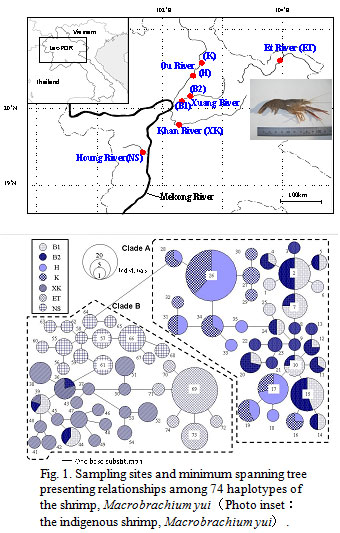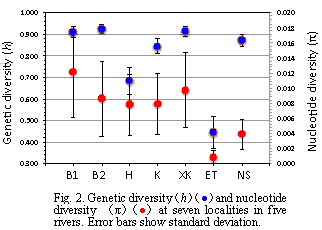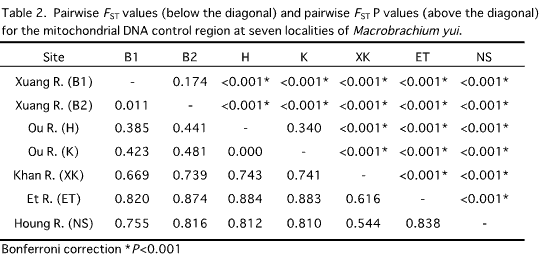Genetic diversity of the shrimp, Macrobrachium yui, indigenous to Laos
Description
The indigenous shrimp, Macrobrachium yui, is utilized as an important living aquatic resource for cash income in northern Laos. Recently, shrimp catch has declined greatly in many fishing sites due to overfishing and deterioration of the river environment. In order to aid recovery of the shrimp stock, we estimated the genetic diversity within a population, the genetic differentiation among populations, and the dynamics of population size in the past using partial mitochondrial DNA control region sequences. In this study, we will suggest measures for shrimp stock recovery suited to each fishing site.
In total, 570 nucleotide sequences were obtained from 355 specimens at seven sampling sites along the Xuang, Ou, Khan, and Houng Rivers of the Mekong River system and the Et River of the Ma River system, in which 58 variable sites were noted and 74 haplotypes were detected (Fig. 1). A minimum-spanning tree (MST) for the shrimp showed two major clades which are linked to each other by 13 base substitutions (Fig. 1). Coefficient of genetic differentiation significantly differed among the five river groups and among localities (Table 1), but not among localities within the same river (Tables 1 and 2), suggesting that the population is structured by the river almost without gene flow. The population at Et River indicated extremely lower genetic and nucleotide diversities than other populations (Fig. 2). Loss of genetic diversity in the Et River population would decrease population growth rate through inbreeding and miniaturization and increase the risk of extinction due to rapid environmental changes. According to the MST (Fig. 1) and mismatch distribution of haplotypes, the Ou (H・K) and Et River (ET) populations have decreased greatly in the past whereas the Khan (XK) and Houng River (NS) populations have remained stable over a long period of time. Only the Et River (ET) population has not reached recovery yet.
Genetic differentiation among M. yui populations along the rivers and stock enhancement without regard to genetic diversity could possibly lead to genetic disturbance of local populations. Therefore, we primarily recommend stock management as a concrete measure for recovery of the shrimp stock.
Shrimp migrating into cave streams for reproduction are easily caught by villagers using bamboo traps. Moreover, some shrimp populations have been greatly been reduced in the past, implying that M. yui is vulnerable to dramatic environmental changes. This suggests the importance of stock management measures such as specifically fishing regulation at the cave stream and habitat conservation.
Stock management of the shrimp should then be carried out at the rivers through the initiative of the villagers with support from the local government. Genetic diversity of shrimp population at the Et River (ET) has been severely reduced; hence, artificial shrimp production under government control may be required as one of effective measures for shrimp stock recovery in the future.
Figure, table
- Affiliation
-
Japan International Research Center for Agricultural Sciences Fisheries Division
- Classification
-
Administration B
- Research project
- Program name
- Term of research
-
FY 2012 (FY 2009-FY2012)
- Responsible researcher
-
Imai Hideyuki ( University of the Ryukyus )
KAKEN Researcher No.: 10359987Ito Akira ( Fisheries Division )
Kounthongbang Aloun ( Living Aquatic Resources Research Center, Lao PDR )
Lasasimma Oulaytham ( Living Aquatic Resources Research Center, Lao PDR )
Souliyamath Pany ( Na-Luang Fisheries Station, Luang-Prabang, Lao PDR )
- ほか
- Publication, etc.
-
Imai et al. (2012) JIRCAS Working Report, 75: 143-148
Ito et al. (2011) Catch and Culture, 17, (2):24-27
- Japanese PDF
-
2012_24_A4_ja.pdf147.83 KB
- English PDF
-
2012_24_A4_en.pdf651.45 KB




